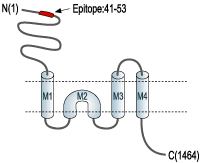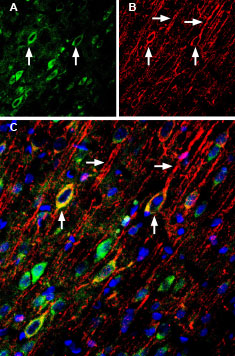Overview
- Peptide GHSHDVTERELRN(C), corresponding to amino acid residues 41-53 of rat NR2A (Accession Q00959). Extracellular, N-terminus.

 Expression of NR2A in mouse brain sectionsImmunohistochemical staining of perfusion-fixed frozen mouse brain sections using Anti-NMDAR2A (GluN2A) (extracellular)-ATTO Fluor-488 Antibody (#AGC-002-AG), (1:80). A. NR2A staining (green) in striatum is detected in neuronal profiles. B. NR2A staining in cingulate cortex is also detected in neuronal profiles. Cell nuclei are labeled with DAPI (blue).
Expression of NR2A in mouse brain sectionsImmunohistochemical staining of perfusion-fixed frozen mouse brain sections using Anti-NMDAR2A (GluN2A) (extracellular)-ATTO Fluor-488 Antibody (#AGC-002-AG), (1:80). A. NR2A staining (green) in striatum is detected in neuronal profiles. B. NR2A staining in cingulate cortex is also detected in neuronal profiles. Cell nuclei are labeled with DAPI (blue).
- Dingledine, R. et al. (1999) Pharmacol. Rev. 51, 7.
- Mayer, M.L. and Armstrong, N. (2004) Annu. Rev. Physiol. 66, 161.
- Prybylowski, K. and Wenthold, R.J. (2004) J. Biol. Chem. 279, 9673.
- Mayer, M.L. (2006) Nature 440, 456.
The NMDA receptors are members of the glutamate receptor family of ion channels that also include the AMPA and Kainate receptors.
The NMDA receptors are encoded by seven genes: one NMDAR1 (or NR1) subunit, four NR2 (NR2A-NR2D) and two NR3 (NR3A-NR3B) subunits. The functional NMDA receptor appears to be a heterotetramer composed of two NMDAR1 and two NMDAR2 subunits. Whereas the NMDAR2 subunits that assemble with the NMDAR1 subunit can be either of the same kind (i.e. two NMDAR2A subunits) or different (one NMDAR2A with one NMDAR2B). NMDAR3 subunits can substitute the NMDAR2 subunits in their complex with the NMDAR1 subunit.
NMDAR is unique among ligand-gated ion channels in that it requires the simultaneous binding of two obligatory agonists: glycine and glutamate that bind to the NMDAR1 and NMDAR2 binding sites respectively. Another unique characteristic of the NMDA receptors is their dependence on membrane potential. At resting membrane potentials the channels are blocked by extracellular Mg2+. Neuronal depolarization relieves the Mg2+ blockage and allows ion influx into the cells. NMDA receptors are strongly selective for Ca2+ influx differing from the other glutamate receptor ion channels that are non-selective cation channels.
Ca2+ entry through the NMDAR regulates numerous downstream signaling pathways including long term potentiation (a molecular model of memory) and synaptic plasticity that may underlie learning. In addition, the NMDA receptors have been implicated in a variety of neurological disorders including epilepsy, ischemic brain damage, Parkinson’s and Alzheimer’s disease.
NMDA receptors expression and function are modulated by a variety of factors including receptor trafficking to the synapses and internalization as well as phosphorylation and interaction with other intracellular proteins.
Application key:
Species reactivity key:
Anti-NMDAR2A (GluN2A) (extracellular) Antibody (#AGC-002) is a highly specific antibody directed against an extracellular epitope of the rat protein. The antibody can be used in western blot, immunoprecipitation, immunocytochemistry, and immunohistochemistry. It has been designed to recognize GluN2A from rat, mouse, and human samples.
Anti-NMDAR2A (GluN2A) (extracellular)-ATTO Fluor-488 Antibody (#AGC-002-AG) is directly labeled with an ATTO-488 fluorescent dye. ATTO dyes are characterized by strong absorption (high extinction coefficient), high fluorescence quantum yield, and high photo-stability. The ATTO-488 label is analogous to the well known dye fluorescein isothiocyanate (FITC) and can be used with filters typically used to detect FITC. Anti-NMDAR2A (GluN2A) (extracellular)-ATTO Fluor-488 Antibody has been tested in immunohistochemistry and is especially suited for experiments requiring simultaneous labeling of different markers.
 Multiplex staining of GluN2A and SynGAP in rat cingulate cortex.Immunohistochemical staining of immersion-fixed, free floating rat brain frozen sections using Anti-NMDAR2A (GluN2A) (extracellular)-ATTO Fluor-488 Antibody (#AGC-002-AG), (1:200) and Anti-SynGAP Antibody (#APZ-032), (1:200), followed by donkey-anti-rabbit-Cy3. A. GluN2A staining (green) appears in neuronal profiles (arrows). B. SynGAP staining (red) is detected mostly in apical dendrites (horizontal arrows) and in neuronal soma (vertical arrows). C. Merge of the two images demonstrates colocalization in some neurons (vertical arrows). Cell nuclei are stained with DAPI (blue).
Multiplex staining of GluN2A and SynGAP in rat cingulate cortex.Immunohistochemical staining of immersion-fixed, free floating rat brain frozen sections using Anti-NMDAR2A (GluN2A) (extracellular)-ATTO Fluor-488 Antibody (#AGC-002-AG), (1:200) and Anti-SynGAP Antibody (#APZ-032), (1:200), followed by donkey-anti-rabbit-Cy3. A. GluN2A staining (green) appears in neuronal profiles (arrows). B. SynGAP staining (red) is detected mostly in apical dendrites (horizontal arrows) and in neuronal soma (vertical arrows). C. Merge of the two images demonstrates colocalization in some neurons (vertical arrows). Cell nuclei are stained with DAPI (blue).
